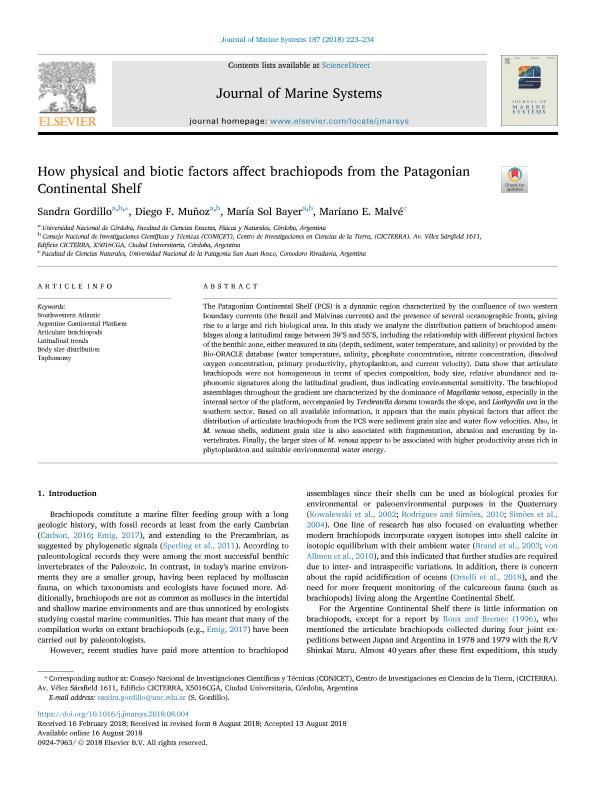Mostrar el registro sencillo del ítem
dc.contributor.author
Gordillo, Sandra

dc.contributor.author
Muñoz, Diego Fernando

dc.contributor.author
Bayer, María Sol

dc.contributor.author
Malvé, Mariano Ezequiel

dc.date.available
2019-11-08T17:29:52Z
dc.date.issued
2018-11
dc.identifier.citation
Gordillo, Sandra; Muñoz, Diego Fernando; Bayer, María Sol; Malvé, Mariano Ezequiel; How physical and biotic factors affect brachiopods from the Patagonian Continental Shelf; Elsevier Science; Journal Of Marine Systems; 187; 11-2018; 223-234
dc.identifier.issn
0924-7963
dc.identifier.uri
http://hdl.handle.net/11336/88354
dc.description.abstract
The Patagonian Continental Shelf (PCS) is a dynamic region characterized by the confluence of two western boundary currents (the Brazil and Malvinas currents) and the presence of several oceanographic fronts, giving rise to a large and rich biological area. In this study we analyze the distribution pattern of brachiopod assemblages along a latitudinal range between 39°S and 55°S, including the relationship with different physical factors of the benthic zone, either measured in situ (depth, sediment, water temperature, and salinity) or provided by the Bio-ORACLE database (water temperature, salinity, phosphate concentration, nitrate concentration, dissolved oxygen concentration, primary productivity, phytoplankton, and current velocity). Data show that articulate brachiopods were not homogeneous in terms of species composition, body size, relative abundance and taphonomic signatures along the latitudinal gradient, thus indicating environmental sensitivity. The brachiopod assemblages throughout the gradient are characterized by the dominance of Magellania venosa, especially in the internal sector of the platform, accompanied by Terebratella dorsata towards the slope, and Liothyrella uva in the southern sector. Based on all available information, it appears that the main physical factors that affect the distribution of articulate brachiopods from the PCS were sediment grain size and water flow velocities. Also, in M. venosa shells, sediment grain size is also associated with fragmentation, abrasion and encrusting by invertebrates. Finally, the larger sizes of M. venosa appear to be associated with higher productivity areas rich in phytoplankton and suitable environmental water energy.
dc.format
application/pdf
dc.language.iso
eng
dc.publisher
Elsevier Science

dc.rights
info:eu-repo/semantics/openAccess
dc.rights.uri
https://creativecommons.org/licenses/by-nc-sa/2.5/ar/
dc.subject
ARGENTINE CONTINENTAL PLATFORM
dc.subject
ARTICULATE BRACHIOPODS
dc.subject
BODY SIZE DISTRIBUTION
dc.subject
LATITUDINAL TRENDS
dc.subject
SOUTHWESTERN ATLANTIC
dc.subject
TAPHONOMY
dc.subject.classification
Biología Marina, Limnología

dc.subject.classification
Ciencias Biológicas

dc.subject.classification
CIENCIAS NATURALES Y EXACTAS

dc.title
How physical and biotic factors affect brachiopods from the Patagonian Continental Shelf
dc.type
info:eu-repo/semantics/article
dc.type
info:ar-repo/semantics/artículo
dc.type
info:eu-repo/semantics/publishedVersion
dc.date.updated
2019-10-23T20:50:51Z
dc.journal.volume
187
dc.journal.pagination
223-234
dc.journal.pais
Países Bajos

dc.journal.ciudad
Amsterdam
dc.description.fil
Fil: Gordillo, Sandra. Consejo Nacional de Investigaciones Científicas y Técnicas. Centro Científico Tecnológico Conicet - Córdoba. Centro de Investigaciones en Ciencias de la Tierra. Universidad Nacional de Córdoba. Facultad de Ciencias Exactas Físicas y Naturales. Centro de Investigaciones en Ciencias de la Tierra; Argentina
dc.description.fil
Fil: Muñoz, Diego Fernando. Consejo Nacional de Investigaciones Científicas y Técnicas. Centro Científico Tecnológico Conicet - Córdoba. Centro de Investigaciones en Ciencias de la Tierra. Universidad Nacional de Córdoba. Facultad de Ciencias Exactas Físicas y Naturales. Centro de Investigaciones en Ciencias de la Tierra; Argentina
dc.description.fil
Fil: Bayer, María Sol. Consejo Nacional de Investigaciones Científicas y Técnicas. Centro Científico Tecnológico Conicet - Córdoba. Centro de Investigaciones en Ciencias de la Tierra. Universidad Nacional de Córdoba. Facultad de Ciencias Exactas Físicas y Naturales. Centro de Investigaciones en Ciencias de la Tierra; Argentina
dc.description.fil
Fil: Malvé, Mariano Ezequiel. Universidad Nacional de la Patagonia "San Juan Bosco". Facultad de Ciencias Naturales - Sede Comodoro; Argentina
dc.journal.title
Journal Of Marine Systems

dc.relation.alternativeid
info:eu-repo/semantics/altIdentifier/url/https://www.sciencedirect.com/science/article/pii/S092479631830037X
dc.relation.alternativeid
info:eu-repo/semantics/altIdentifier/doi/http://dx.doi.org/10.1016/j.jmarsys.2018.08.004
Archivos asociados
